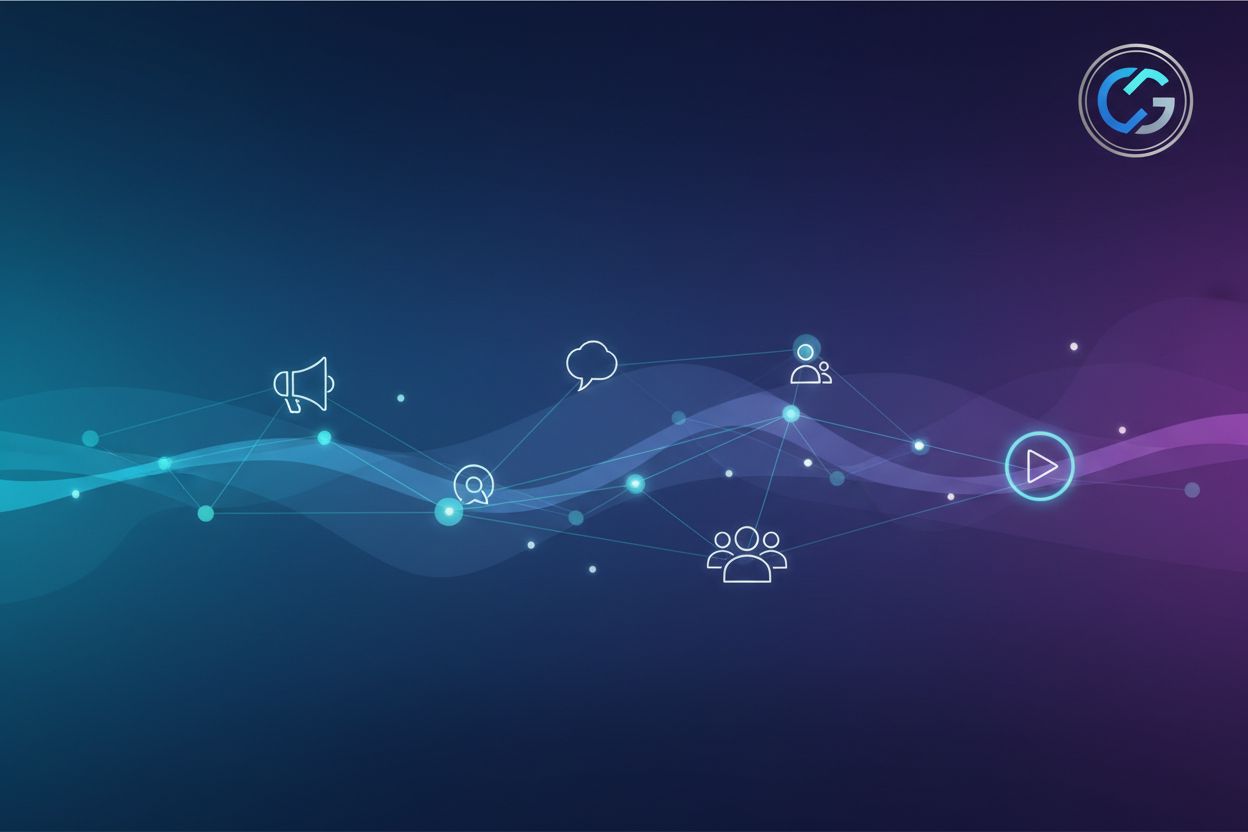Measuring Content ROI with AI: A Practical Guide for Marketers
TL;DR
The Imperative of AI-Driven Content ROI Measurement
AI is revolutionizing marketing, but are you truly measuring its impact? Many marketers are still using outdated methods that fail to capture the full picture of content ROI. AI can overcome attribution challenges by enabling sophisticated multi-touch attribution models, capture indirect benefits like brand lift through sentiment analysis, and move beyond vanity metrics by focusing on conversion-driven KPIs.
According to a 2024 McKinsey report, companies using ai in marketing see 20-30% higher ROI compared to traditional approaches. However, many struggle to quantify ai's value beyond simple metrics. This section highlights why ai-driven ROI measurement is essential for modern marketers.
Traditional ROI measurement often misses the complex, long-term impact of content. These methods struggle to capture the full value of ai-driven campaigns.
- Attribution challenges: Multi-touch attribution is difficult without ai. Traditional models often fail to accurately assign credit across various touchpoints in the customer journey.
- Ignoring indirect benefits: Indirect benefits like brand lift and operational efficiencies are frequently overlooked. These intangible gains can significantly contribute to overall ROI.
- Overemphasis on vanity metrics: Focusing solely on metrics like click-through rates (CTR) or impressions provides an incomplete picture. It ignores downstream conversions and customer lifetime value.
AI offers a more holistic and accurate approach to measuring content ROI. According to Hurree.co, ai's value often compounds over time, which simple metrics cannot capture. (Reliance on metrics is a fundamental challenge for AI - ScienceDirect)
- Comprehensive data collection: AI can automate data collection from multiple sources. (AI Data Collection: Key Concepts & Best Practices - Nexla) It enables real-time dashboards to visualize and highlight performance, as noted by Hurree.co.
- Improved forecasting: AI enhances forecasting accuracy. It allows you to compare ai-predicted outcomes versus actual results.
- Scalability: AI provides content production scalability, increasing the output of ad variations and localization speed. This is a key reason why ai is so important for improving content ROI.
To leverage ai effectively, marketers must avoid common pitfalls in ROI measurement.
- Establish a performance baseline: Document current performance before ai implementation to accurately measure improvement.
- Account for total costs: Include all costs associated with ai projects (development, infrastructure, training) to determine net gain.
- Focus on long-term advantages: Evaluate ai based on its compounding long-term advantages rather than immediate results only.
Clear measurement is crucial to justify ai investments and avoid costly experiments. By moving beyond vanity metrics, marketers can demonstrate the real business impact of ai-driven content.
In the next section, we'll outline best practices for establishing a structured approach to measuring ai's impact on content ROI.
Best Practices for a Structured AI ROI Measurement Approach
Is your ai implementation truly on track for success? A structured approach to measuring ROI is vital to ensure your efforts are paying off.
The first step in a structured approach is to define SMART goals for your ai initiatives. SMART goals are Specific, Measurable, Achievable, Relevant, and Time-bound. This framework helps ensure that your goals are well-defined and attainable. By setting SMART goals, marketers create clear targets against which they can directly measure the impact of ai initiatives, making it easier to attribute financial gains or cost savings to specific ai implementations.
- Align AI initiatives with broader business goals. For example, a healthcare provider might set a goal to reduce patient readmission rates by 15% within six months using ai-powered predictive analytics.
- Objectives must be Specific, Measurable, Achievable, Relevant, and Time-bound. A retail company could aim to increase online sales conversion rates by 10% in the next quarter by implementing ai-driven personalized product recommendations.
- SMART goals provide a solid foundation for tracking success. A financial institution might target a 25% reduction in fraud detection time within a year using ai-based anomaly detection systems.
Next, it's essential to establish a performance baseline before implementing ai. This involves capturing key metrics before ai implementation to have a point of comparison.
- Capture key metrics (sales, satisfaction, efficiency) before AI implementation. For instance, a logistics company should record its current delivery times and fuel consumption rates before deploying ai-optimized routing.
- Create a benchmark to measure performance changes. A customer service department should track average call resolution times and customer satisfaction scores before introducing ai-powered chatbots.
- Directly attribute improvements to AI efforts. After ai implementation, compare the new metrics against the baseline to accurately measure the impact and return on investment.
Finally, understanding the true ROI requires accounting for total costs and calculating net benefits. This includes all expenses associated with the ai project.
- Consider all costs: development, infrastructure, licenses, training, maintenance. For example, an ai-driven content creation tool includes the cost of the software, the infrastructure to run it, and the training for employees to use it effectively.
- Calculate net benefits by subtracting total costs from achieved benefits. If an ai project generates $100,000 in additional revenue but costs $60,000 to implement, the net benefit is $40,000.
- Provides a clear view of total investment and payoff. This holistic approach ensures a clear understanding of the true impact of ai on your content ROI.
By following these best practices, you can create a structured approach to measure ai ROI. In the next section, we will explore the specific metrics that should be monitored to fully understand ai's impact.
Key Metrics to Track for Comprehensive AI ROI Assessment
Are you ready to delve into the metrics that truly matter for ai-driven content ROI? It’s time to move beyond vanity metrics and focus on what drives real business impact.
These metrics show ai's direct contribution to your bottom line. Focus on these to understand how ai impacts revenue.
- Incremental revenue from AI-optimized campaigns: Compare sales from ai-enhanced campaigns (e.g., dynamic pricing, personalized recommendations) against traditional methods. For instance, a retail company can measure the additional revenue generated by ai-powered product recommendations compared to generic recommendations.
- Customer Lifetime Value (CLV) improvements: Measure how ai-driven retention strategies (e.g., churn prediction models, hyper-personalized offers) increase long-term customer value. A subscription-based service, for example, can track how ai-driven personalized offers reduce churn and increase CLV.
- Lead-to-Customer conversion rate increases: Track improvements from ai-powered lead scoring and nurturing. A B2B software company could monitor how ai-enhanced lead scoring leads to more qualified leads and higher conversion rates.
AI should reduce costs and save time. Quantify these operational gains to justify ai investments.
- Cost Per Acquisition (CPA) reduction: Measure how ai-optimized ad bidding or audience targeting lowers acquisition costs. An e-commerce business can compare CPA for ai-targeted ads versus traditionally targeted ads.
- Time saved on manual tasks: Track hours reclaimed from ai automation (e.g., report generation, segmentation, A/B testing). A marketing team, for example, can monitor how much time ai saves on tasks like automated report generation.
- Campaign launch speed: Compare how much faster ai-assisted workflows execute campaigns. A large enterprise can compare campaign launch times with and without ai assistance.
AI's impact on engagement and loyalty is crucial. Monitor these metrics for a comprehensive view.
- Engagement rate improvements: Track improvements in open rates, click-through rates, and session duration from ai personalization. For instance, a media company can measure increased engagement from AI-driven content personalization.
- Churn rate reduction: Measure how ai-powered retention alerts (e.g., "at-risk customer" flags) lower attrition. A telecommunications company can track how ai-driven churn alerts reduce customer attrition.
- Net Promoter Score (NPS) improvement: Assess whether ai-driven interactions (e.g., chatbots, dynamic content) boost customer satisfaction. A financial institution can gauge NPS scores for ai-powered customer service interactions.
By tracking these key metrics, you gain a comprehensive understanding of ai's impact on your content ROI. In the next section, we will explore strategic and operational metrics.
Strategic & Operational Metrics for Long-Term Optimization
Building on the core metrics, this section focuses on strategic and operational indicators that provide a longer-term view of ai's impact. AI-driven content optimization is not a one-time event but an ongoing process. To truly maximize ROI, marketers need to track metrics that provide insights into long-term performance. This section explores strategic and operational metrics crucial for optimizing ai's impact over time.
One of the most strategic metrics to monitor is forecasting accuracy. AI models are used to predict future outcomes, such as demand or sales. By comparing these AI-predicted outcomes against the actual results, marketers can assess the reliability of their models.
- Compare AI-predicted outcomes (demand, sales) vs. actual results: This involves a systematic review of how well the ai's predictions align with real-world data. For example, if an ai model predicts a 15% increase in sales for a specific product line, compare this against the actual sales increase achieved.
- Identify areas for model refinement and improvement: When discrepancies arise between predicted and actual outcomes, it's essential to identify the underlying causes. Was the ai's training data incomplete, or were there external factors that the model didn't account for?
- Improve strategic decision-making based on reliable forecasts: Accurate forecasts drive better business decisions. If the ai consistently predicts outcomes with high precision, marketers can confidently allocate resources, plan campaigns, and set realistic goals.
Another vital metric is content production scalability. AI's ability to automate content creation processes can significantly increase output. Measuring this scalability helps quantify the efficiency gains from ai.
- Measure how AI increases content output (ad variations, localization speed): For instance, track the number of ad variations that ai can generate in a given timeframe compared to manual methods. Also, measure how quickly ai can translate and localize content for different markets.
- Quantify the impact on overall marketing agility: This involves assessing how ai improves the team's ability to respond to new opportunities and challenges. Can ai quickly adapt content strategies based on real-time feedback and market trends?
- Assess the ability to respond quickly to market changes: AI can improve marketing agility. It allows teams to respond to market changes more quickly.
Finally, competitive benchmarking provides valuable context for evaluating ai's performance. By comparing ai-driven results against industry averages, marketers can identify areas where they excel and areas where they need to improve.
- Compare AI-driven performance against industry averages (CTR, CPA, conversion rates): For example, compare the CTR of ai-optimized ads against the average CTR for similar ads in your industry. Similarly, benchmark your CPA and conversion rates against industry standards.
- Identify competitive advantages and areas for improvement: Benchmarking helps pinpoint what your organization does well and where you might be falling behind. If your ai-driven campaigns consistently outperform competitors in specific areas, you can leverage those advantages.
- Ensure AI efforts are keeping pace with or exceeding industry standards: This proactive approach ensures that your ai investments are delivering a competitive edge. If you identify gaps in performance, take steps to refine your ai strategies and catch up with industry leaders.
By monitoring these strategic and operational metrics, marketers gain a holistic view of ai's long-term impact.
The AI ROI Formula: A Holistic Assessment
Unlock the true potential of your ai investments by understanding the ai ROI formula. This formula provides a structured way to measure the profitability and impact of ai on your content efforts.
To accurately assess ai ROI, consider the following key components:
- Revenue Gains: Measure the incremental revenue generated from ai-optimized campaigns. For example, a retail company can compare sales from ai-powered product recommendations against sales from generic recommendations.
- Cost Savings: Quantify operational efficiencies and reduced expenses due to ai implementation. A marketing team can track the time saved on manual tasks through ai-driven automation.
- Retention Benefits: Assess the increase in Customer Lifetime Value (CLV) and reduction in churn rate from ai-driven retention strategies. A subscription-based service can measure how ai-driven personalized offers reduce churn and increase CLV.
- Total AI Costs: Include all costs associated with ai projects, such as development, infrastructure, licenses, training, and maintenance. An ai-driven content creation tool includes the cost of the software, the infrastructure to run it, and the training for employees to use it effectively.
These components allow marketers to understand ai's multifaceted contributions to the bottom line.
First, calculate your Net Benefits by summing Revenue Gains, Cost Savings, and Retention Benefits. Then, to determine the ROI Percentage, divide the Net Benefits by the Total AI Costs and multiply by 100. This percentage communicates the profitability and impact of your ai project.
This formula provides a clear, quantifiable measure of ai's impact. By understanding the ai ROI formula, marketers can gain a holistic assessment of their ai investments.
Leveraging AI Writing Assistants and Automation Tools
AI writing assistants and automation tools are rapidly changing how marketers create content. These technologies not only speed up the content creation process but also offer powerful features to optimize and personalize content for better ROI.
AI tools accelerate content creation, which frees up human marketers to focus on strategy and higher-level tasks. AI can assist with tasks such as generating initial drafts, suggesting headlines, and even creating entire articles based on provided keywords and data. This automation allows marketing teams to produce more content in less time.
- Efficiency: AI writing assistants can generate articles, blog posts, and social media content much faster than traditional methods. This speed is particularly useful for time-sensitive campaigns.
- Consistency: AI ensures consistent brand messaging across all content platforms. This consistency helps maintain a cohesive brand identity, which is crucial for building customer trust.
- Cost-Effectiveness: By automating content creation, companies can reduce the need for large content teams. This reduction leads to significant cost savings in the long run.
AI-powered content optimization enhances engagement and conversions by analyzing data to identify what resonates with the target audience. These tools can suggest improvements to readability, SEO keywords, and overall content structure. By leveraging ai, marketers can create content that is more likely to attract and retain readers.
- SEO Enhancement: AI tools analyze search engine algorithms to identify the most effective keywords. It helps in optimizing content for better search engine rankings.
- Readability Improvement: AI assesses readability scores and suggests ways to simplify complex language. It ensures that content is accessible to a broader audience.
- Performance Prediction: AI can predict the performance of content based on historical data. This allows marketers to refine their strategies by allocating budget to high-potential content formats or topics, thereby maximizing their return on investment.
Personalization at scale becomes achievable through ai-driven automation, which allows marketers to tailor content to individual customer preferences. AI can analyze customer data to create personalized email campaigns, product recommendations, and website content. This level of personalization significantly improves customer engagement and loyalty.
- Dynamic Content: AI enables the creation of dynamic content that changes based on user data. This ensures that each customer sees content relevant to their specific needs.
- Personalized Recommendations: AI algorithms analyze customer behavior to provide personalized product recommendations. It increases the likelihood of conversions and sales.
- Targeted Messaging: AI helps in crafting targeted messages that resonate with specific customer segments. This ensures that marketing efforts are more effective and efficient.
AI writing assistants and automation tools provide marketers with the means to create more content, optimize it for better performance, and personalize it at scale. In the next section, we'll look ahead to how ai is shaping the future of content ROI measurement.
The Future of Content ROI Measurement with AI
AI's transformative journey in content ROI measurement continues, promising even more refined strategies and insights. What can marketers expect as ai technology evolves?
AI-driven predictive analytics will allow marketers to forecast future ROI based on current performance data. By analyzing historical trends and various performance metrics, ai models can predict outcomes and optimize strategies proactively.
- Forecasting future ROI: AI algorithms can predict how different content strategies will perform over time. This allows marketers to allocate resources effectively.
- Identifying trends: AI can identify emerging trends and patterns in content performance. This enables you to capitalize on new opportunities and stay ahead of the competition.
- Data-backed decisions: By leveraging ai-driven forecasts, marketers can make more informed decisions about future content investments.
The measurement of ROI should be seen as an ongoing process. By regularly evaluating and refining the approach, marketers can ensure that ai's value is maximized over time.
- Ongoing process: ROI measurement should not be a one-time exercise but an ongoing process. This ensures that your ai initiatives remain aligned with business goals.
- Regularly review: Regularly review your measurement approach to identify areas for improvement. This helps you refine your strategies and optimize ai's impact.
- Maximize value: A commitment to continuous improvement maximizes the long-term value of ai. This guides long-term strategy and improves future initiatives.
AI tools can analyze content performance across multiple languages, providing marketers with valuable insights into regional differences and preferences. This enables you to optimize content strategies for global audiences, ensuring that your message resonates with diverse cultures and markets.
- Analyze content performance: AI tools can analyze content performance across multiple languages. This helps you understand how your content resonates with different audiences.
- Understand regional differences: Gain insights into regional differences in engagement and conversions. This enables you to tailor your content to specific markets.
- Optimize global content strategies: Optimize content strategies for global audiences by leveraging ai-driven insights. This ensures that your message is relevant and effective in all regions.
As ai technology continues to advance, marketers must embrace these future trends to unlock the full potential of ai-driven content ROI measurement. This will ensure better informed decisions, optimized strategies, and greater overall success.
Conclusion
So, we've talked a lot about why measuring content ROI with ai is super important, right? It's not just about getting more clicks or likes anymore; it's about really understanding what's working and what's not, and how ai can help us do that way better than before. We looked at how ai can fix those tricky attribution problems, how it helps us see the indirect stuff like brand awareness that traditional methods miss, and how it steers us away from just chasing those flashy but empty vanity metrics.
We also went over some practical ways to actually do this – like setting those SMART goals, which are key, and making sure we're looking at the whole picture, not just the easy bits. And the metrics! We covered the revenue ones, the cost-saving ones, and even the engagement ones. Plus, we touched on the future, which is looking pretty wild with ai getting even smarter.
The main takeaway here is that if you're not using ai to measure your content ROI, you're probably leaving money on the table and not really getting the full story. It's about being smarter, more efficient, and ultimately, getting a better return on all that content you're putting out there. So, start digging into those numbers, embrace the ai tools, and let's get a clearer picture of what's really driving success.







